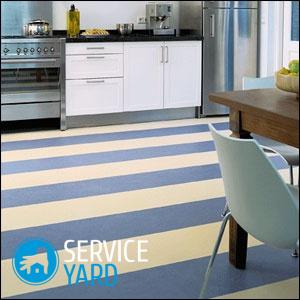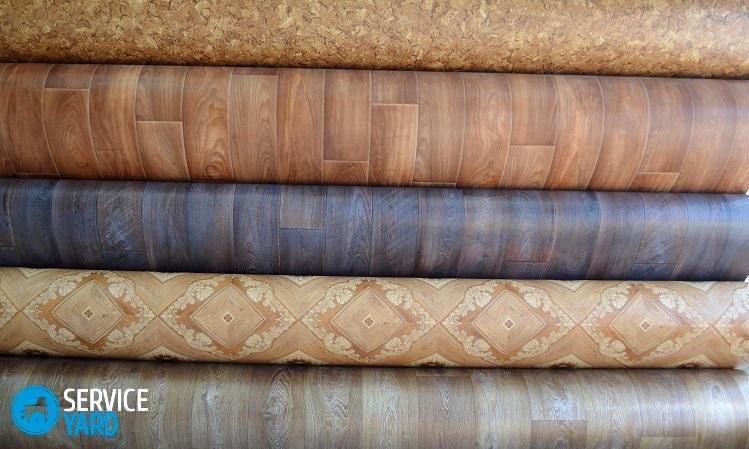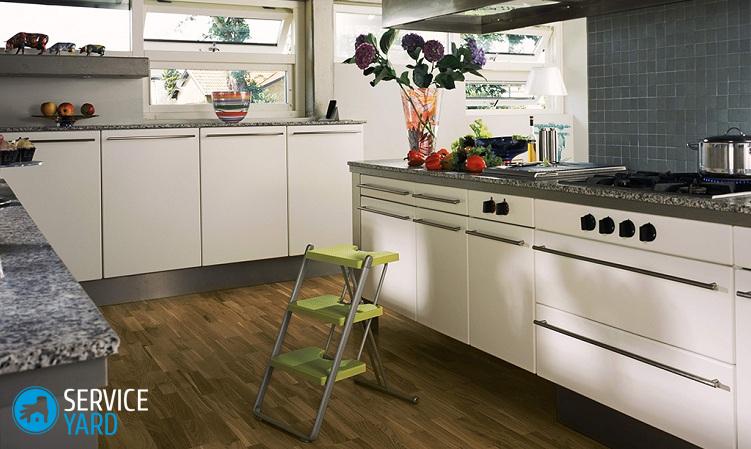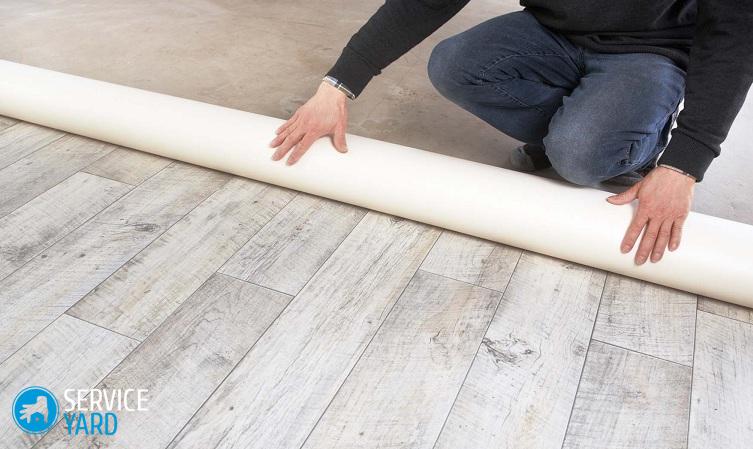What linoleum to choose for the kitchen?

Among the many floor coverings, linoleum is one of the most popular. For the kitchen, this option is suitable due to the excellent characteristics and excellent qualities of the material. However, the specificity of the kitchen places high demands on which linoleum to choose for the kitchen. We will understand in this article how not to make a mistake when buying.
to contents ↑Linoleum for the kitchen - the advantages of the material
If you still doubt whether it is worth covering the floor with linoleum in the kitchen, then the listed advantages of the material can convince you of this:
- High degree of sound insulation.
- Excellent thermal insulation properties.
- The material is particularly wear resistant.
- It is resistant to various detergents, including aggressive ones.
- Simple installation.
- Soft surface of linoleum. Unlike tiles or laminate, utensils falling to the floor will most likely not break.
- Attractive price. The price range is very wide, depending on the quality of linoleum, design and properties.
What is going on in the kitchen?
In order to understand how to choose high-quality linoleum for the kitchen, you need to understand the conditions in which it will be operated:
- Obviously, the kitchen floor is subject to maximum loads. Family members are constantly in this room: they have lunch, dinner and breakfast, drink tea and just talk. Also, the hostess moves around the room during cooking. In addition to household members, the kitchen sometimes hosts guests.
- Another feature of the kitchen flooring is its predisposition to pollution. Again, due to constant cooking, various crumbs, drops of tea and coffee, and fatty oil fall on the floor. As a result, the floor in the room is often washed.
These factors are basic in order to choose the best linoleum for the kitchen.
to contents ↑Types of linoleum coating
So, after understanding the requirements for the material, let's take a closer look at what types of linoleum are. And also, what are their features, pros and cons.
Household, commercial and semi-commercial linoleum
How to choose linoleum for the kitchen, based on this classification? This division into types is carried out according to the degree of wear resistance of the coating.
Consider each of them:
- Commercial. This type of linoleum is used for flooring in public places: office centers, hospitals, schools. Thus, the coating has to endure significant loads, so the thickness of the protective film is up to 0.8 mm.
- Semi-commercial type. In such linoleum, the thickness of the protective coating is not higher than 0.6 mm. Strength and wear resistance of the material is able to withstand a sufficient load within the same housing. In addition, it is recommended to lay it in the corridors and hallways, where there is also increased cross-country ability. The price of such flooring is not much higher. And the laying process is easy and simple.
Important! It is believed that this type is the best linoleum for the kitchen in terms of material wear.
- Domestic. In terms of quality, this species has the lowest characteristics. The thickness of the protective layer does not exceed 0.3 mm. For the kitchen, this coating is better not to use, it is more justified in living rooms with less load.
Also, the flooring material is divided by its composition into synthetic and natural.
Natural linoleum
Based on the name, it is easy to guess that the composition of this material includes natural components. These include:
- Wood flour. It gives the coating an appropriate smoothness and also helps maintain linoleum color for a long service life.
- Wood resins. They give strength and elasticity to the flooring.
- Linseed oil. Serves as the basis for creating a natural coating.
- Natural coloring pigments. With their help give different shades of linoleum.
- Jute fiber. This component is designed for the production of substrates and is highly hygienic.
Which linoleum to choose for the kitchen - natural or artificial, will help determine their advantages. Natural material has such advantages:
- Environmental friendliness. Of course, this is the first advantage of coverage, which speaks about the safety for the health of all family members.
- Long linoleum life.
Important! Proper care will preserve the excellent appearance of the coating for more than a dozen years.
- A high degree of strength, wear resistance of such linoleum.
- Hygiene The material has bactericidal properties. Therefore, the possibility of the appearance of a fungus or harmful bacteria, as well as their reproduction, is practically excluded.
- Not afraid of ultraviolet radiation, does not fade.
- The surface of linoleum has an antistatic effect.
- Easy to clean and care for the surface of the coating, the material does not respond to the use of chemicals.
Important! Linoleum from natural components has many design designs - a variety of colors, textures, ornaments.
But there are some disadvantages of this flooring:
- High price. Sometimes the cost of such linoleum is comparable to the price of an elite parquet or laminate.
- The possibility of parasite damage is not ruled out if there are appropriate conditions in the room. This option is unlikely, but you should still consider it.
- Laying the cover is a bit more complicated than PVC material.
Artificial linoleum
If you are interested in how to choose high-quality linoleum for the kitchen, then you need to understand the difference between synthetic and natural materials.
Features of artificial turf are as follows:
- The composition from which linoleum is made. The basis for artificial flooring is polyvinyl chloride.
- A different production technology than natural material.
- Low cost.
- Operational characteristics.
Since the basis of the material is PVC, linoleum has its inherent qualities: strength, moisture resistance, wear resistance, thermal insulation.
Important! Artificial material with a wide layer of foamed PVC can withstand a significant load, and in this parameter can even surpass natural flooring.
Another advantage of artificial material is its versatility. You can use it anywhere: in an apartment, in a summer house, summer house or veranda.
Artificial linoleum, in turn, is divided into two types - single-layer and multi-layer.
Single and multi-layer linoleum
Let's try to find out what is the best linoleum for the kitchen, depending on its layering. First, we learn what a homogeneous material, that is, a single layer.
Important! This type of linoleum is homogeneous, does not have a basis in its structure, but this does not make it poor-quality. This material is notable for its strength and sufficient coating thickness.
Advantages of single-layer linoleum:
- The thickness of the material does not exceed 3 mm, but this parameter is enough to ensure that the coating is durable and dense for the kitchen.
- Compared with other types, homogeneous material is lighter, which is convenient for transportation.
- Low price. Lower than that of a layered species.
- The drawing is applied across the entire thickness of linoleum, which provides good abrasion resistance.If the floor surface will wear out unevenly, it will not be so noticeable to the eye.
- The material with a rough texture is well suited for the kitchen, as it makes it difficult to slip. And on such a surface, various contaminants are less noticeable.
Important! A single-layer type of coating has a short service life of about five years. But this period can be increased if the surface of linoleum is treated with protective agents, as well as the rules of care and maintenance are observed. Then the term will be about ten years. By the way, it is homogeneous linoleum that is most often used for underfloor heating.
What linoleum to choose for the kitchen is still possible? - The opposite to a single-layer type is multilayer, or heterogeneous, material, which consists of the following layers:
- Fiberglass impregnated with PVC mixture.
- The basis.
- Layer with design.
- Protective transparent layer.
- Substrate. It can be chemical or mechanical.
Important! Due to this structure, the material has high wear resistance to mechanical damage and various deformations, which is very important for the kitchen.
The main advantages of multilayer linoleum are its high density and strength. In addition, there are several more advantages:
- Higher quality sound and heat insulation than a homogeneous coating. Such characteristics are determined by the thickness of the material within 6 mm.
- The upper protective layer plays a special role: the larger it is, the less damage there will be on linoleum, and its service life will increase.
- In addition to standard layers, manufacturers can complement the structure of linoleum to give it additional properties. For example, include the sixth layer, which will have anti-slip or anti-static characteristics.
Important! The approximate term of use of such linoleum is about ten years.
But there are several drawbacks of a multilayer coating:
- High price.
- After a certain period of time, scuffs appear on the surface.
- Difficult transportation.
- Linoleum is heavier, so its installation will be more difficult.
Flooring selection
You are already aware of the types of coverage and their features. It remains to find out how to choose the right linoleum for the kitchen, what exactly should you focus on?
We list these nuances:
- The coating must have absolute water resistance, because in the kitchen vaporization necessarily takes place, condensation forms, and it is possible that water or other liquids can spill. Under these conditions, the floor must not be exposed to moisture.
- Linoleum with a relief or intricate texture will not be a good solution for the kitchen. In the process of cooking, fat and steam settle on the surface of furniture, appliances and floor. A floor with a smaller texture will be much easier and faster to clean from dirt.
- However, the best linoleum for the kitchen is not a completely smooth option. In this case, the floor with traces of fat or just wet will become incredibly slippery and dangerous for households.
- The design of the coating is not recommended to choose unnecessarily clumsy. Complex ornaments and colorful colors most often “overload” the room of a small kitchen. And the interior of the room in most cases is modest and concise.
- The kitchen floor is washed most often than everyone else in the apartment. Sometimes cleaning is done several times a day. Therefore, it is so important that the surface of linoleum does not respond to the use of household chemicals.
- Pay attention to the antibacterial properties of the coating. For the kitchen, it is best to choose those species that have the highest hygiene.
- Thick material is more difficult to lay, and at the same time, the design of the seams, if any, should be provided. Of course, ideally, you need to select a roll across the width of the room to avoid joining.
- Natural linoleum can be distinguished from artificial linoleum in two ways: price and smell.The price of synthetic material is much lower, in addition, it has a chemical smell. A natural coating has the aroma of natural oils that make up its composition. Another sign is the flexibility of the coating - natural bending is more difficult.
- Of course, the thicker the building material, the longer its life.
Color and design of linoleum
If you decide which linoleum to choose for the kitchen by color, then this is the final stage of selecting the coating in the room. The range is striking in its diversity and versatility of design. Manufacturers of natural material were able to come up with technologies that give linoleum bright and saturated colors. In addition, the colors do not fade in the sun, and the coating will delight you with its appearance for many years. Artificial linoleum has even greater decorative capabilities.
Important! PVC flooring can qualitatively and naturally convey natural materials: stone, wood, brick, ceramics.
Design Principles:
- The flooring in its shade should be combined with the color of the walls and furniture set. Most often, linoleum is selected two tones lower than the base background.
- You can apply another, more contrasting technique. In the event that the kitchen is designed in the same tone, you can emphasize the finish of the floor of the opposite or bright color.
Color solutions:
- The most popular linoleum color is brown.
- In modern design, gray, beige, black, blue tones, as well as bright and saturated shades, are successfully used.
Patterns and style
Which linoleum to choose for the kitchen: with or without a pattern? Which ornament will be optimal?
- The design of the flooring should be in tune with the stylistic direction of the decor. So, the interior of the kitchen in the Art Nouveau style will complement the linoleum with a geometric pattern or with imitation “under the parquet”.
- The classic setting allows the use of material with floral patterns, as well as smooth curved ornaments.
- Decorate the floor of the kitchen in the style of Minimalism with monophonic linoleum - the presence of patterns is excluded, and discreet elegant touches on the surface are acceptable.
to contents ↑Important! One of the fashionable trends in the decoration of the floor is linoleum, the design of which does not consist of ragged cells, but consists of an original ornament in the center.
Floor preparation
Now you know how to choose the right linoleum for the kitchen. It remains to install it. The process must begin with the preparation of the floor surface. Installation of linoleum is carried out on a perfectly flat and hard floor.
Important! The smaller the thickness of the material, the more even and smooth the surface should be. Otherwise, coating wear will be much faster.
The sequence of actions is as follows:
- If possible, remove the previous coating.
- Remove any irregularities and protrusions on the floor, and plaster over any cracks or bumps.
Important! You can make the floor absolutely even with a special composition for leveling. This would be ideal for preparing the floor.
- After treating the floor and drying it completely, the surface must be sanded.
- Then we recommend vacuuming the floor and only then start laying linoleum.
to contents ↑Important! The coating is laid only on an absolutely dry surface, otherwise - linoleum can swell. In addition, an unpleasant smell of mustiness will appear.
Laying linoleum
There are three methods for spreading linoleum:
- Roll. This standard installation forms in the kitchen a continuous surface without any seams. Linoleum is fixed by means of floor plinths. Traditional linoleum does not require special skills, and you can cope with styling on your own. In addition, manufacturers are happy to provide you with detailed instructions for each specific material.
- Tile. This installation method is used for tiled linoleum.The convenience of such a coating is the ability to independently transport the material and spread it. The aesthetic appearance of the finish depends on careful installation, so each element is glued to the floor separately.
- Liquid. This is the most modern way of finishing the floor, also known as bulk floor. Liquid linoleum is poured onto a prepared smooth surface. The technology is quite complicated, so it is better to resort to the services of specialists.
to contents ↑Important! Thicker material is harder to stack.
Stock footage
So we analyzed how to choose high-quality linoleum for the kitchen. Taking into account information about the types and characteristics of the coating, you can easily find the most optimal and stylish flooring for the kitchen.
- How to choose a vacuum cleaner taking into account the characteristics of the house and coatings?
- What to look for when choosing a water delivery
- How to quickly create comfort at home - tips for housewives
- How to choose the perfect TV - useful tips
- What to look for when choosing blinds
- What should be running shoes?
- What useful things can you buy in a hardware store
- Iphone 11 pro max review
- Than iPhone is better than Android smartphones






